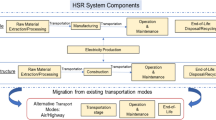Abstract
Intention, Goal, Scope, Background, Objectives
Environmental effects caused by the railway transport services have rarely been investigated in depth from a systemic point of view. A screening LCA, called ecology profile, of the German high-speed passenger train system, the ICE, is presented here, based on a study conducted by the University of Halle and the Deutsche Bahn AG, the major German rail operator. In this study, the resource consumption caused by traction, manufacturing and maintenance of ICE trains, as well as construction and operation of the supporting rail infrastructure and buildings, have been evaluated using cumulative energy demand (CED), cumulative material input per service unit (MIPS) and CO2 emissions as indicators.
Methods
Approximately 200 items of inventory data were collected from DB AG experts, manufacturers, site balances and the associated literature. They were allocated in order to derive 100-person-kilometre-related mass and energy consumption figures. The appropriate CED, MIPS and CO2 factors were applied in order to quantify the indirect efforts associated with the inventory data.
Conclusions
For the reference high-speed route investigated, Hanover-Wuerzburg, the railroad infrastructure does not contribute the high share of resource consumption to the life cycle of the transport service which was expected from other studies. For the reference route, the CED of the infrastructure contributes 13% to the total CED per 100 person kilometres, whilst the energy demand of the traction process dominates the life cycle. Within the railway infrastructure, the construction of tunnels and the heating of rail points during winter time are significant primary-energy active components, whereas the energy requirement for maintaining the railway stations is a minor factor in comparison. The environmental impact of new technologies for designing rail tracks have also been analysed. The new ballastless slab track technology investigated needs higher absolute resource inputs in the construction phase compared with the traditional gravel bed, but due to higher life expectancy, it competes favourably at the 100-person-kilometre level, at least in terms of material requirements. Efforts to reduce the traction energy consumption of the ICE train will have the greatest impact on the CED of the transport system. In summary, a total of 48 kg of solid primary resources are needed for a passenger to travel 100 km by ICE.
Recommendations/Outlook
The results presented can be used for modelling other high-speed railway transport systems. A comparison of the ecology profiles of the German, French and Japanese high-speed train systems would be of interest in order to identify potential areas for improvement. Additional studies are needed to evaluate the short-hop, commuter train service. Further efforts should be directed to comparing the infrastructure of the high speed train and that of highway road traffic.
Similar content being viewed by others
References
Maibach M, Peter D, Seiler B (1995): ökoinventar Transporte-Grundlagen für den ökologischen Vergleich von Transportsystemen und den Einbezug von Transportsystemen in ökobilanzen. INFRAS, Zurich 1995; updated 1999
VDI Association of Engineers Germany (1997): Cumulative energy demand — Terms, definitions, methods of calculation. Beuth, Berlin/Vienna/Zurich
Institute for Applied Ecology, öko-Institut (2001): Global Emission Model for Integrated Systems — GEMIS 4.0. http:// www.oeko.de/service/gemis/english/index.htm: status: 05/2001
MIPS online (2001): http://www2.wupperinst.org/Projekte/ mipsonline/: status: 07/2001
Deutsche Bahn AG (2000): Systemgrenzen Umrechnungsfaktoren für Energiekennzahlen. DB AG internal paper
Forschungsstelle für Energiewirtschaft FfE (2001): Analyse von Energie- und Stoffströmen — Basisdaten für die ökologische Bewertung von Unternehmen, Wirtschaftsgütern und Dienstleistungen. http://www.ffe.de/details/gabie/bilanz.htm: status 2001
Eyerer P, Reinhardt HW (2000): ökologische Bilanzierung von Baustoffen und Gebäuden — Wege zu einer ganzheidichen Bilanzierung. Birkhäuser
Institute for Applied Ecology, öko-Institut (2001): Kumulierter Energie-Aufwand: mehr als eine Zahl; http://www.oeko.de/ service/kea/: status: 2001
Hübner H, Dunkel T et al. (1997): Transrapid zwischen ökonomie und ökologie — Eine Technikwirkungsanalyse alternativer Hochgeschwindigkeits-Verkehrssysteme. DMV
Gawel E (1998): Das Elend der Stoffstromökonomie — Eine Kritik. Konjunkturpolitik 44
Schütz H, Bringezu S (1993): Major Material Flows in Germany. Fresenius Environmental Bull 2, 1993, 443–448
Deutsche Bahn AG (2000): Geschäftsbericht 2000 Teil 2: Daten und Fakten. http://www.bahn.de/extrahtml/pdf/daten und fakten 2000.pdf
Ilgmann G (1998): Der Zukunft verpflichtet — Gewinner und Verlierer einer CO2-Steuer im Güter- und Personenverkehr. Ludwig Bölkow Stiftung, Ottobrunn
Deutsche Bahn AG (2000): Daten/Fakten DB Netz 2000. http:// www.bahn.de/konzern/netz/wir/die bahn ziele fakten.shtml: status: 10/2001
Bundesamt für Umwelt, Wald und Landschaft (1995): Bauprodukte und Zusatzstoffe in der Schweiz. Schriftenreihe Umwelt 245, BUWAL; Bern
ISO TC 207/SC 5 (1998): ISO 14040: Environmental management — Life cycle assessment — Principles and framework. Beuth
Author information
Authors and Affiliations
Corresponding author
Rights and permissions
About this article
Cite this article
Rozycki, C.v., Koeser, H. & Schwarz, H. Ecology profile of the german high-speed rail passenger transport system, ICE. Int J LCA 8, 83–91 (2003). https://doi.org/10.1007/BF02978431
Received:
Accepted:
Issue Date:
DOI: https://doi.org/10.1007/BF02978431




